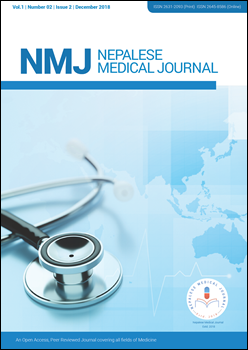Use of Handheld Ultrasound to Estimate Fluid Status of Hemodialysis Patients
DOI:
https://doi.org/10.3126/nmj.v1i2.21584Keywords:
Central venous pressure, Dry weight, Fluid status, Handheld ultrasound, Inferior vena cavaAbstract
Introduction: Accurate assessment of fluid status in hemodialysis patients presents a significant challenge. Nephrologists have long relied on dry weight estimation based solely on clinical parameters to decide the ultrafiltration volume for patients with end-stage kidney disease on dialysis. However, this method is far from accurate and many patients recurrently suffer from signs and symptoms of fluid overload or circulatory collapse from overaggressive ultrafiltration. Invasive methods such as measurement of central venous pressure cannot be used routinely. We evaluated the usefulness of inferior vena cava (IVC) diameter measured by handheld ultrasound in the estimation of fluid status in patients before and after hemodialysis.
Materials and Methods: Clinical assessment included patients’ symptoms, weight, blood pressure, heart rate, and presence of edema before and after dialysis session. Dry weight was assessed based on the above parameters. Each patient underwent measurement of inferior vena cava before and after hemodialysis. The anteroposterior IVC diameter (IVCD) was measured 1.5 cm below the diaphragm in the hepatic segment in supine position during normal inspiration and expiration.
Results: Thirty hemodialysis patients (mean age 51.6±18.03 years) were evaluated in outpatient dialysis unit. Following hemodialysis mean IVCe (IVC diameter in expiration) decreased from 1.40±0.38 to 0.91±0.30 cm (p<0.001). Similarly, mean IVCi (IVC diameter in inspiration) decreased from 0.67±0.34 to 0.35±0.19 cm (p<0.001). Changes in IVCD were significantly correlated with alterations in body weight following dialysis (p<0.0001). The IVC collapsibility index (IVC-CI, per cent of change in IVC diameter in expiration vs. inspiration) increased significantly from 0.53±0.18 to 0.68±0.18 after dialysis (p=0.002). IVC diameter and IVC-CI clearly reflected alterations in fluid status. Regarding the clinical parameters of fluid status, following hemodialysis, mean heart rate increased from 81.17±5.21 beats per minute to 86.50±7.99, (p=0.003), systolic blood pressure increased from 148.67±26.36 mmHg to 155.00±28.50, (p=0.05), and diastolic blood pressure increased from 78.62±12.74 mmHg to 84.83±14.55, (p<0.001).
Conclusions: Our findings support the applicability of IVCD measurement and IVC-CI in the estimation of fluid status in end stage kidney disease patients on hemodialysis. The clinical parameters of fluid status including heart rate, systolic blood pressure, and diastolic blood pressure suggest that significant numbers of patients underwent excess ultrafiltration based on their traditional dry weight calculation. Thus, using IVC parameters before and during hemodialysis might give a better estimation of fluid status of the patient and guide the amount of ultrafiltration to be done.
Downloads
866
553
Downloads
Published
How to Cite
Issue
Section
License
Copyright on any article published by Nepalese Medical Journal is retained by the author(s).
Authors grant Nepalese Medical Journal a license to publish the article and identify itself as the original publisher.
Authors also grant any third party the right to use the article freely as long as its integrity is maintained and its original authors, citation details and publisher are identified.




